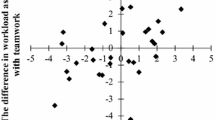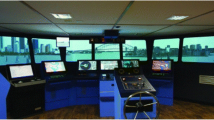Abstract
This paper presents the COWORK2 method, designed to classify the collective tasks of a fighter jet patrol according to two classification criteria: mental workload (at individual level) and communication quality (at team level). The classification purpose is to detect the tasks for which collective work could be impaired. A three-stage method is developed. Stage 1 consists in carrying out a task analysis with a subject matter expert to identify the collective tasks and characterize them in terms of commonly occurring situations and functions (constraints). In Stage 2, data related to individual mental workload (physiological measures) and team communications (communication recordings) are collected from a low-intrusiveness device in a highly realistic simulation environment. Stage 3 finally produces the classification of patrol collective tasks according to the two levels of analysis: individual and team. This classification is corroborated by the risk-level categorization of collective tasks achieved by a subject matter expert. The results highlight the relevance of the COWORK2 method.








Similar content being viewed by others
Explore related subjects
Discover the latest articles and news from researchers in related subjects, suggested using machine learning.References
Boomer DS (1965) Hesitation and grammatical encoding. Lang Speech 8:148–158
Cannon-Bowers JA, Salas E (1997) A framework for developing team performance measures in training. In: Brannick MT, Salas E, Prince C (eds) Team performance assessment and measurement: theory, methods, and applications. LEA, Mahwah, pp 45–62
Clark HH, Brennan SE (1991) Grounding in communication. In: Resnick LB, Levine JM, Teasley SD (eds) Perspectives on socially shared cognition. American Psychological Association, Washington, pp 127–149
Corradini P, Cacciari C (2002) The effect of workload and workshift on air traffic control: a taxonomy of communicative problems. Cogn Technol Work 4(4):229–239
Dehais F, Causse M, Pastor J (2008) Embedded eye tracker in a real aircraft: new perspectives on pilot/aircraft interaction monitoring. In: 3rd international conference on research in air transportation proceedings. Federal Aviation Administration, Fairfax
Endsley MR (1995) Toward a theory of situation awareness in dynamic systems. Hum Factors 37(1):32–64
Gerin W, Pieper C, Pickering TG (1994) Anticipatory and residual effects of an active coping task on pre-and post-stress baselines. J Psychosom Res 38(2):139–149
Gibson W, Megaw E, Young M, Lowe E (2006) A taxonomy of human communication errors and application to railway track maintenance. Cogn Technol Work 8(1):57–66
Gorman JC, Cooke NJ, Winner JL (2006) Measuring team situation awareness in decentralized command and control environments. Ergonomics 49(12–13):1312–1325
Guerin C, Leroy B, Chauvin C, Coppin G (2014) Task analysis from the expert point of view: a prerequisite condition to analyse physiological activity of fighter pilot aircraft. Poster presented at HFES European chapter. Lisbon, Portugal
Hankins TC, Wilson GF (1998) A comparison of heart rate, eye activity, EEG and subjective measures of pilot mental workload during flight. Aviat Space Environ Med 69:360–367
Hoc JM (2001) Towards a cognitive approach to human–machine cooperation in dynamic situations. Int J Hum Comput Stud 54(4):509–540
Karavidas MK, Lehrer PM, Lu SE, Vaschillo E, Vaschillo B, Cheng A (2010) The effects of workload on respiratory variables in simulated flight: a preliminary study. Biol Psychol 84:157–160
Kasarskis P, Stehwien J, Hickox J, Aretz A, Wickens C (2001) Comparison of expert and novice scan behaviors during VFR flight. Paper presented at the 11th international symposium on aviation psychology. The Ohio State University, Columbus
Klein G, Feltovich PJ, Woods DD (2004) Common ground and coordination in joint activity. In: Rouse WR, Boff KB (eds) Organizational simulation. Wiley, New York
Klein G, Feltovich PJ, Bradshaw JM, Woods DD (2005) Common ground and coordination in joint activity. Organ Simul 53:139–184
Lahlou S (2011) How can we capture the subject’s perspective? An evidence-based approach for the social scientist. Soc Sci Inf 50:607–655
Lassalle J, Rauffet P, Leroy B, Guillet L, Chauvin C, Coppin G (2014). Innovative multi-sensors device deployment for fighter pilots activity study in a highly realistic Rafale simulator. Paper at HFES European chapter. Lisbon, Portugal
Lee Y-H, Liu B-S (2003) Inflight workload assessment: comparison of subjective and physiological measurements. Aviat Space Environ Med 74(10):1078–1084
Lehrer P, Karavidas M, Lu SE, Vaschillo E, Vaschillo B, Cheng A (2010) Cardiac data increase association between self-report and both expert ratings of task load and task performance in flight simulator tasks: an exploratory study. Int J Psychophysiol 76:80–87
Marshall SP (2002) Method and apparatus for eye tracking and monitoring pupil dilation to evaluate cognitive activity. Patent US 6090051A. U.S. Patent and Trademark Office, Washington
Mollo V, Falzon P (2004) Auto- and allo-confrontation as tools for reflective activities. Appl Ergon 35(6):531–540
Mouloua M, Gilson R, Kring J, Hancock P (2001) Workload, situation awareness, and teaming issues for UAV/UCAV operations. In: Proceedings of the 45th human factors and ergonomics society (HFES), pp 162–165
Nählinder S, Berggren P, Svensson E (2004) Reoccurring LISREL patterns describing mental workload, situation awareness and performance. In: Proceedings of the 48th human factors and ergonomics society (HFES)
Prinzo OV (2001) Data-linked pilot reply time on controller workload and communication in a simulated terminal option (technical report DOT/FAA/AM-01/8). Civil Aeromedical Institute, Office of Aviation Medicine Federal Aviation Administration
Salas E, Cooke NJ, Rosen MA (2008) On teams, teamwork, and team performance: discoveries and developments. Hum Factors 50(3):540–547
Sami S, Seppänen M, Kuusela A (2004) Artefact correction for heart beat interval data. In: Proceedings of 1st Probisi
Storm H, Fremming A, Odegaard S, Martinsen O, Morkrid L (2000) The development of a software program for analyzing spontaneous and externally elicited skin conductance changes in infants and adults. Clin Neurophysiol 111:1889–1898
Svensson EA, Wilson GF (2002) Psychological and psychophysiological models of pilot performance for systems development and mission evaluation. Int J Aviat Psychol 12(1):95–110
Veltman JA (2002) A comparative study of psychophysiological reactions during simulator and real flight. Int J Aviat Psychol 12:33–48
Veltman JA, Gaillard AWK (1996a) Physiological indices of workload in a simulated flight task. Biol Psychol 42:323–342
Veltman JA, Gaillard AWK (1996b) Pilot workload evaluated with subjective and physiological measures. In: Brookhuis K, Weikert C, Moraal J, de Waards D (eds) Aging and human factors, proceedings of the Europe chapter of the ergonomics society. Traffic Research Center, University of Groningen, Haren
Veltman JA, Gaillard AWK (1998) Physiological workload reactions to increasing levels of task difficulty. Ergonomics 41:656–669
Wilson GF (2002a) An analysis of mental workload in pilots during flight using multiple psychophysiological measures. Int J Aviat Psychol 12:3–18
Wilson GF (2002b) A comparison of three cardiac ambulatory recorders using flight data. Int J Aviat Psychol 12:111–119
Wilson GF, Fullenkamp P, Davis I (1994) Evoked potential, cardiac, blink, and respiration measures of pilot workload in air-to-ground missions. Aviat Space Environ Med 65:100–105
Xiao Y, Hunter WA, Mackenzie CF, Jefferies NJ, Horst RL (1996) Task complexity in emergency medical care and its implications for team coordination. Hum Factors 38:636–645
Yao YJ, Chang YM, Xie XP, Cao XS, Sun XQ, Wu YH (2008) Heart rate and respiration responses to real traffic pattern flight. Appl Psychophysiol Biofeedback 33:203–209
Ylonen H, Lyytinen H, Leino T, Leppaluoto J, Kuronen P (1997) Heart rate responses to real and simulated BA Hawk MK 51 flight. Aviat Space Environ Med 68:601–605
Acknowledgements
The development and the deployment of the COWORK2 method was supported by the TAPAS project (Technique d’Analyse pour le Partage d’Autorité dans les Systèmes des systèmes/Analysis Techniques for Shared Authority in the Systems of systems) supported by the French National Research Agency (ANR) and the French Defense Agency (DGA) involving Dassault Aviation and the Lab-STICC research laboratory. This project would not have been possible without the approval of the Navy Air Base at Landivisiau, France, and the assistance of all the members of the Rafale Simulation Center team. The authors are also grateful to all the fighter pilots who agreed to participate in this project.
Author information
Authors and Affiliations
Corresponding author
Rights and permissions
About this article
Cite this article
Lassalle, J., Rauffet, P., Leroy, B. et al. COmmunication and WORKload analyses to study the COllective WORK of fighter pilots: the COWORK2 method. Cogn Tech Work 19, 477–491 (2017). https://doi.org/10.1007/s10111-017-0420-8
Received:
Accepted:
Published:
Issue Date:
DOI: https://doi.org/10.1007/s10111-017-0420-8




